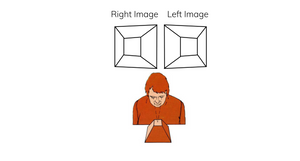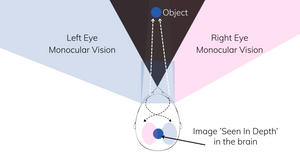A Parent’s Guide to Stereovision and Your Child’s Development
What Is Stereovision?
Stereovision is the ability to perceive depth and see the world in 3D using information jointly from left and right eyes.
It relies on both eyes sending slightly different images to the brain, which uses these differences to create a sense of depth. Some children are born with conditions like strabismus (eye misalignment) or amblyopia (‘lazy eye’, which is weak visual acuity that cannot be resolved by spectacle lenses). These conditions can interfere with this process, leading to poor stereovision or even stereoblindness.
Why Have Two Eyes?
At first, one might think it’s for depth perception, but close one eye, and we can still judge spatial distances between objects quite well. In fact, some remarkable people, like the renowned cricketer Nawab of Pataudi and aviator Wiley Post (the first to fly solo around the world), excelled in their fields with just one eye.
So why do we have two? It's about how they’re positioned on our heads. Like some other animals, we have foward-facing eyes. Other animals' eyes are positioned with their eyes on the sides of their heads.


Rabbits have eyes situated on either side of their heads. Tigers' eyes, like ours, face forward.
Prey animals - like rabbits and pigeons - have eyes on the sides of their heads, giving them a wide field of view to spot approaching danger. Predators - like tigers and owls - have forward-facing eyes, just as we do.
This forward-facing eye alignment allows for stereoscopic vision, where both eyes work together to detect depth and 'break through' camouflage - an essential skill for hunters. Breaking camouflage can be achieved by seeing the target object standing up above the ground on which it lies.

Stereoscopic vision is very good at breaking camouflage
For humans, stereoscopic vision isn’t just about survival; it’s crucial for navigating the world, judging distances, catching a ball, or even pouring a drink. It’s a powerful ability, one we often take for granted or underestimate the impact for those who don’t have it.
Why Binocular Vision Matters
The ability of both eyes to work together to perceive depth is also called binocular vision. If a child has poor binocular vision – poor stereovision - they may struggle with some activities, potentially affecting everything from their performance in sports to their ability to read, write, and focus in school.
How We See in Bionocular Vision
The human visual system processes depth by integrating the slightly different images captured by each eye. These images are transmitted via the optic nerves, with the right eye's image primarily processed in the left hemisphere of the brain and the left eye's image processed in the right hemisphere. This occurs because the optic nerves partially cross each other, ensuring that visual information from both eyes is combined in the visual cortex at the back of the brain.
The brain analyses the disparities between the two images - the small differences in the position of the objects viewed by the eyes - to calculate depth. This process, known as stereopsis (from the Greek stereos, meaning "solid," and opsis, meaning "sight"), allows us to perceive a three-dimensional world. By measuring these disparities, the brain constructs a detailed depth map, enabling precise spatial awareness and effective interaction with our environment.


How Common Are Stereovision Problems?
Research suggests that 3-5% of the global population lacks stereovision and have to navigate the world without binocular depth perception. However, many are unaware of their condition because they have adapted to seeing in a two-dimensional way. The brain can use other kinds of optical information to generate depth perception, such as perspective, shading, texture variations, head movements etc, and these allow many people lacking stereovision to get by quite well, including driving cars.
How Stereovision Affects Everyday Life
As a parent, you may notice:
- Clumsiness or frequent tripping
- Difficulty catching or throwing objects
- Avoidance of sports or activities requiring depth judgment
- Complaints of headaches or tired eyes after reading
- Squinting or closing one eye when focusing on something
- A head tilt when looking at objects
If you recognise these signs, it may be beneficial to have your child’s vision assessed by an eye care professional.
Can Stereovision Be Improved?
Emerging evidence over the last 20-30 years has demonstrated that some children, and even adults, lacking stereovision can develop stereovision through vision therapy. Depending on the cause, treatments may include:
- Patching Therapy: Strengthening a weaker eye by covering the dominant one.
- Prisms or Special Lenses: Helping to align the eyes correctly.
- Vision Therapy Exercises: Training the brain and eyes to work together more effectively. These are structured programmes through exercises and regular visual tasks designed to strengthen eye coordination and address underlying visual issues. These can be particularly beneficial for children. Modern approaches sometimes take advantage of video games providing stereoscopic depth information to train the use of that information.
- Surgical Options: In cases of severe strabismus, surgery may be considered.
Early diagnosis is key to the best outcomes. With the right intervention, some children and adults experience a joyous transformation as their world shifts from flat to 3D, improving their confidence, coordination, and ability to engage in daily activities.
Indeed, Susan R Barry , Professor Emeritus of Biological Sciences and Professor Emeritus of Neuroscience and Behaviour at Mount Holyoke College USA, , wrote about her experience of regaining binocular vision as a 50 year old, following an entensive programme of vision therapy.
“As I looked up to adjust the rearview mirror, the mirror popped out at me, floating in front of the windshield. I was transfixed. Throughout the day, my stereovision would emerge — intermittently, fleetingly, unexpectedly—bringing me moments of absolute wonder and delight.
"The most ordinary objects looked so beautiful. A large sink faucet reached out toward me, and I thought I had never seen such a lovely arc as the arc of the faucet. The grape in my lunchtime salad was rounder and more solid than any grape I had ever seen before.
"I could see, not just infer, the volume of space between tree limbs, and I loved looking at, and even immersing myself in, those inviting pockets of space.”
An excerpt from Fixing My Gaze by Susan R Barry, 2009, pp. 94–95
Adults With Reduced Depth Perception
Adults with impaired depth perception may struggle with:
- Driving and Parking – Estimating distances between vehicles, stopping accurately, and parking safely.
- Navigating Stairs – Judging step height and placement, increasing the risk of missteps or falls.
- Walking on Pebbles
- Cooking Safely – Handling knives, using the stove, and baking with precision.
- Playing Sports – Tracking moving objects like balls and
accurately judging distances between players.
Enhancing Depth Perception
Struggling with depth perception can be challenging, but there are ways to improve it:
- Vision Therapy – Programmes, similar to those for children,
designed over time to strengthen eye coordination and address visual processing
issues
- Eye Exercises – Focusing on objects at different distances
or practicing specific eye movements to improve coordination
- Corrective Lenses – In some cases, glasses or contact lenses may
help enhance depth perception
- Environmental Adjustments – Improving lighting and
increasing contrast in areas like kitchens and staircases to make daily tasks
easier
The Frisby Stereotest
The Frisby Stereotest is a simple, glasses-free test that can help detect stereovision problems in children, babies as young as 6 months, and adults.
By identifying depth perception difficulties early, parents and eye care professionals can work together to develop a management plan that gives children the best possible chance to improve their vision and quality of life.
If you have concerns about your child’s stereovision, speak to an eye
care professional and ask about stereovision testing.

